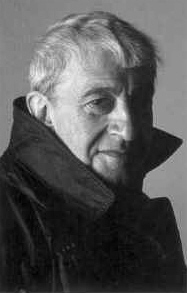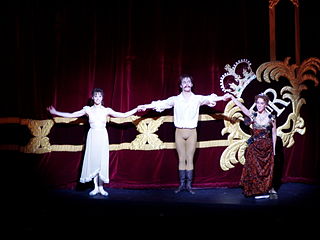Notes
- ↑ "Winter Dreams", Royal Opera House Collections Online, retrieved 8 October 2014
- 1 2 "The Judas Tree". Kenneth MacMillan official Website. "The Judas Tree". Archived from the original on 2015-03-03. Retrieved 2014-12-01.
- ↑ "Technical error".
The Judas Tree is a one-act ballet created by Kenneth MacMillan in 1992 for the Royal Ballet. The music is by Brian Elias.
The first performance was on 19 March 1992, at the Royal Opera House, Covent Garden. [1]
The only clue MacMillan gave in order to understand his intentions is a programme note quoting Kahlil Gibran's poem "On Crime and Punishment": ‘[A]s a single leaf turns not yellow but with the silent knowledge of the whole tree, so the wrongdoer cannot do wrong without the hidden will of you all’. [2]
According to the information at MacMillan's official website, this ballet is about "betrayal and guilt, individual and communal". The plot references the biblical betrayal story of the Kiss of Judas, which leads directly to the arrest of Jesus and his later crucifixion. In this same source it is said that MacMillan was also thinking of contemporary "instances of betrayal, such as the Tiananmen Square massacre in 1989." Since the protesting students demanding democratic reforms were taken down by the Chinese army, "in spite of politicians’ assurances that there would be no violence". [2]
The Royal Ballet website describes it like this: "The Judas Tree is MacMillan's final ballet, and still his most controversial. MacMillan commissioned a score from Brian Elias for the ballet, which had its premiere in 1992. Both MacMillan and Elias were inspired not only by Biblical stories of betrayal but also by contemporary events – the violence in Tiananmen Square; the creation of the financial district in Canary Wharf. As MacMillan admitted of the finished work, ‘There are things in me that are untapped and that have come out in this ballet that I find frightening’." [3]
The current production of the ballet is staged in a way that is reminiscent of West Side Story . A single woman is in the presence of three main male dancers in a bleak urban landscape. Although it is not explicit in the choreography, the woman is physically abused at several points, raped, and eventually murdered by a wider gang. Although she is sometimes portrayed as a victim, she is not always a passive participant, but also wields what power she has to attract, rebut or humiliate some of her suitors. The narrative ends with one of her lovers being blamed for her death, and betrayed by a kiss from the real culprit. The man is murdered by the gang, and the culprit then hangs himself from the scaffolding. The programme notes recommend that this is not a ballet for children under the age of 12.

The Royal Ballet is a British internationally renowned classical ballet company, based at the Royal Opera House in Covent Garden, London, England. The largest of the five major ballet companies in Great Britain, the Royal Ballet was founded in 1931 by Dame Ninette de Valois. It became the resident ballet company of the Royal Opera House in 1946, and has purpose-built facilities within these premises. It was granted a royal charter in 1956, becoming recognised as Britain's flagship ballet company.

The Royal Ballet School is a British school of classical ballet training founded in 1926 by the Anglo-Irish ballerina and choreographer Ninette de Valois. The school's aim is to train and educate outstanding classical ballet dancers, especially for the Royal Ballet and the Birmingham Royal Ballet.
Judas Tree is a common name for a flowering tree, Cercis siliquastrum with the common name a reference to the biblical New Testament suicide of Judas Iscariot after betraying the Messiah Jesus Christ in the Land of Palestine where the tree species is endemic to.

Sir Kenneth MacMillan was a British ballet dancer and choreographer who was artistic director of the Royal Ballet in London between 1970 and 1977, and its principal choreographer from 1977 until his death. Earlier he had served as director of ballet for the Deutsche Oper in Berlin. He was also associate director of the American Ballet Theatre from 1984 to 1989, and artistic associate of the Houston Ballet from 1989 to 1992.

Alessandra Ferri OMRI is an Italian prima ballerina. She danced with the Royal Ballet (1980–1984), American Ballet Theatre (1985–2007) and La Scala Theatre Ballet (1992–2007) and as an international guest artist, before temporally retiring on 10 August 2007, aged 44, then returning in 2013. She was eventually granted the rank of prima ballerina assoluta.
Brian Elias is a British composer.
L'histoire de Manon, generally referred to as Manon, is a ballet choreographed by Kenneth MacMillan to music by Jules Massenet and based on the 1731 novel Manon Lescaut by Abbé Prévost. The ballet was first performed by The Royal Ballet in London in 1974 with Antoinette Sibley and Anthony Dowell in the leading roles. It continues to be performed and recognised internationally.
Dame Merle Park, is a British ballet dancer and teacher, now retired. As a prima ballerina with the Royal Ballet during the 1960s and 1970s, she was known for "brilliance of execution and virtuoso technique" as well as for her ebullience and charm. Also admired for her dramatic abilities, she was praised as an actress who "textured her vivacity with emotional details."

Lynn Seymour was a Canadian-born ballerina, mostly associated with the Royal Ballet in London. She was a muse of choreographer Kenneth MacMillan, creating lead roles in Romeo and Juliet, The Invitation, Concerto, Anastasia and Mayerling, among others. She originated lead roles for several ballets by Frederick Ashton, including The Two Pigeons, Five Brahms Waltzes in the Manner of Isadora Duncan and A Month in the Country. She also guested with various ballet companies throughout her life.

Mayerling is a ballet choreographed by Kenneth MacMillan to the music of Franz Liszt, arranged by John Lanchbery, scenario by Gillian Freeman and designed by Nicholas Georgiadis. The ballet is based on the Mayerling incident, a series of events surrounding the apparent murder–suicide of Rudolf, Crown Prince of Austria and his lover, Baroness Mary Vetsera. The ballet premiered on 14 February 1978, at the Royal Opera House, danced by The Royal Ballet, with David Wall as Prince Rudolf and Lynn Seymour as Vetsera.
Mara Galeazzi is an Italian ballet dancer actress and choreographer.She was a Principal Dancer of The Royal Ballet.
Maryon Lane was a South African ballet dancer who became well known in Britain as a ballerina of the Sadler's Wells Theatre Ballet and as a soloist with the Royal Ballet.
Choreographer Sir Kenneth MacMillan's Royal Ballet production of Sergei Prokofiev's Romeo and Juliet premiered at the Royal Opera House, Covent Garden on 9 February 1965.

Viviana Durante is an Italian ballet dancer, considered one of the great dramatic ballerinas of recent times. She was a principal dancer of The Royal Ballet, American Ballet Theatre, Teatro alla Scala and K-Ballet. She is the artistic director of English National Ballet School and of the Viviana Durante Company.
Irek Dzhavdatovich Mukhamedov OBE, is a Soviet-born British ballet dancer of Tatar origin who has danced with the Bolshoi Ballet and the Royal Ballet. Born in Kazan, he trained at the Moscow Choreographic Institute under the guidance of Alexander Prokofiev between 1970 and 1978. Upon graduation, he joined the Classical Ballet Company, where he spent three years touring around the world. It was with this company that he first danced Romeo, a role that was to become one of his most acclaimed. In 1981 he won the Grand Prix and gold medal at the International Ballet Competition in Moscow and was immediately invited to join the Bolshoi Ballet as a principal dancer, where he not only became Grigorovich's favourite danseur but went to become the youngest man ever to dance the leading role in Spartacus.
Jonathan Cope is a British ballet dancer. He was a principal dancer at The Royal Ballet until his retirement in 2006, then served as a répétiteur with the company until 2019.

The Song of the Earth is a ballet based on Das Lied von der Erde, a symphonic work written by the Austrian composer Gustav Mahler in 1908–1909. It is scored for two voices and orchestra, and has been used for ballets by several well-known choreographers, including Antony Tudor (1908–1987), Kenneth MacMillan (1929–1992), Heinz Spoerli, and John Neumeier.
Concerto is a one-act ballet in three movements created by Kenneth MacMillan in 1966 for the Deutsche Oper Ballet. The music is Dmitri Shostakovich's Second Piano Concerto (1957). The ballet premiered on 30 November 1966.
Ross MacGibbon is a British former ballet dancer, and now a film maker, especially for ballet and opera.